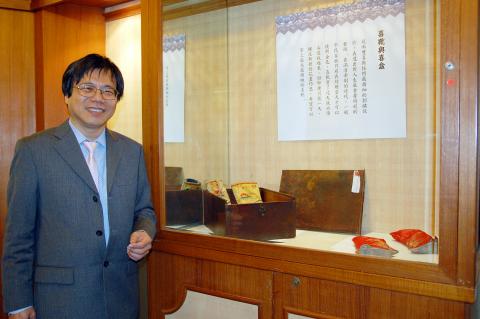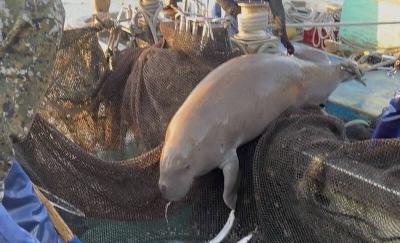A physician, who has been interested in the Chinese practice of foot binding since an early age, has put his collection of thousands of artifacts on display.
The result of David Ko’s (柯基生) endeavor over the past three decades is being exhibited through Jan. 26 at the Sansia History Museum in Sansia District (三峽), New Taipei City (新北市).
Ko said the foot-binding custom has more than 1,000 years of history in China, while it was only in the relatively modern era that Taiwan took up the practice.

Photo: Wang Kai-lin, Taipei Times
“Foot-binding was introduced to Taiwan by the occupying army of the Ming Dynasty warlord Koxinga [Cheng Chen-kung, 鄭成功] in the 17th century, but it only really spread to the common folk in the 19th century,” he said.
“In the beginning, the settlers from China were mostly poor and faced difficult living conditions in Taiwan. It was only later on when some people became prosperous, that female foot-binding became more common, especially among urban residents,” said. “At its peak, one estimate indicated that up to 70 percent of women in Taiwan had their feet bound.”
Women’s rights activists have said the custom amounts to enslaving females — giving them a life of pain and restricted movement. They have said it was the Chinese patriarchal society’s way of suppressing women — deforming their feet to satisfy a male notion of erotic desire. As such, activists have said it should not be romanticized nor promoted as some kind of fashion concept or an appealing cultural legacy.
Ko said his research showed that the Hakka, mountain Aboriginal groups and lowland Pingpu Aboriginals did not practise footbinding, but due to increased interaction with Han Chinese over the centuries, some of the groups took up the practice.
The practice resulted in what was known by the Chinese as the “three-inch golden lotus” (三寸金蓮). The Chinese inch (寸) is a little longer than 3cm so the preferred foot length was less than 10cm.
Ko said the woven and embroidered shoes used to bind feet were not as refined in Taiwan as those made in China because of the custom’s short history in the nation.
“However, there are localized differences and we do have specialty styles that are distinct from Chinese styles,” he added.
Most of the tiny shoes used to bind feet in Taiwan were various shades of red to express family bliss and vitality, Ko said.
The early migrants from the Zhangzhou and Chuanzhou regions of Fujian Province incorporated the wooden high-heel slippers from their cultures, which enclosed the bound feet and gave them a slender look, Ko said.
Ko, who has a collection of more than 6,000 pairs of the shoes, said he began to study foot-binding customs when he was about 10 and said that “it led to an interest in physiology and formed his thinking to become a medical doctor.”
Sansia District Administrator Yang Chih-hung (楊志宏) said his great-grandmother had bound feet.
“Through systematic collection, compilation and planning, the public will have a deeper understanding about this old custom,” Yang said of the exhibit.

‘DENIAL DEFENSE’: The US would increase its military presence with uncrewed ships, and submarines, while boosting defense in the Indo-Pacific, a Pete Hegseth memo said The US is reorienting its military strategy to focus primarily on deterring a potential Chinese invasion of Taiwan, a memo signed by US Secretary of Defense Pete Hegseth showed. The memo also called on Taiwan to increase its defense spending. The document, known as the “Interim National Defense Strategic Guidance,” was distributed this month and detailed the national defense plans of US President Donald Trump’s administration, an article in the Washington Post said on Saturday. It outlines how the US can prepare for a potential war with China and defend itself from threats in the “near abroad,” including Greenland and the Panama

A wild live dugong was found in Taiwan for the first time in 88 years, after it was accidentally caught by a fisher’s net on Tuesday in Yilan County’s Fenniaolin (粉鳥林). This is the first sighting of the species in Taiwan since 1937, having already been considered “extinct” in the country and considered as “vulnerable” by the International Union for Conservation of Nature. A fisher surnamed Chen (陳) went to Fenniaolin to collect the fish in his netting, but instead caught a 3m long, 500kg dugong. The fisher released the animal back into the wild, not realizing it was an endangered species at

The Chinese Nationalist Party (KMT) is maintaining close ties with Beijing, the Democratic Progressive Party (DPP) said yesterday, hours after a new round of Chinese military drills in the Taiwan Strait began. Political parties in a democracy have a responsibility to be loyal to the nation and defend its sovereignty, DPP spokesman Justin Wu (吳崢) told a news conference in Taipei. His comments came hours after Beijing announced via Chinese state media that the Chinese People’s Liberation Army’s Eastern Theater Command was holding large-scale drills simulating a multi-pronged attack on Taiwan. Contrary to the KMT’s claims that it is staunchly anti-communist, KMT Deputy

The High Prosecutors’ Office yesterday withdrew an appeal against the acquittal of a former bank manager 22 years after his death, marking Taiwan’s first instance of prosecutors rendering posthumous justice to a wrongfully convicted defendant. Chu Ching-en (諸慶恩) — formerly a manager at the Taipei branch of BNP Paribas — was in 1999 accused by Weng Mao-chung (翁茂鍾), then-president of Chia Her Industrial Co, of forging a request for a fixed deposit of US$10 million by I-Hwa Industrial Co, a subsidiary of Chia Her, which was used as collateral. Chu was ruled not guilty in the first trial, but was found guilty